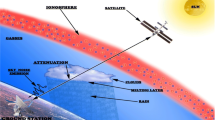Abstract
For any communication service operating in the Microwave/ Millimeter wave region, statistical information characterising the attenuation due to rain along satellite slant path would be required for the design of satellite communication links and for the broadcasting network above 20 Ghz. It is necessary to have a prior knowledge of the probability of exceeding different levels of rain attenuation in order to design appropriate fade margins into systems and establishing estimates of the year to year variability of rain fade margin for particular geographic regions of India so that the communication system reflects the extremes of these variabilities. Direct measurement of beacon signals from geostationary satellites have been a mean to determine the above information and experiments can be pursued with satellite such as INSAT. [1]
Attenuatiuon of Millimeter Waves by rainfall restricts the path length of a communication system. A knowledge of the rain attenuation at such frequencies is therefore desirable in designing a reliable communication system. Signal level fading over line-of-sight links strongly depends on the hop length, frequency and climate. For short hops, the probability of occurance of deep fades becomes diminishingly small. However, since an extended hop length is possible for regions with little rain activity, clear weather fading can affect the link reliability in a similar way ti a rain.[2]
Similar content being viewed by others
REFERENCES
Goldhirsh, “Rain Rate Statistics and Fade Distribution at 20 and 30 GHz Derived from a Network of Rain Guages in the Mid-Atlantic Coast over a Five year periods”, IEEE Transaction on Antennas and Propagation, vol 40,No.11, November 1992, pp 1408–1416.
“Millimeter Wave Radio for short haul Urban Links”, IED December 1989, pp19–23.
Thiagrajan Viswanathan, “Telecommunication Switching Systems and Networks”, PHI Publication 1995, pp-347–350.
Johnston, “Millimeter radar”, Microwave Journal, Nov. 1977
Robert M. Gagliardi “Satellite Communication”, CBS pub. 1987, pp96–101.
Ali. “Optimum hop length of Millimeter Wave radio Links in an arid climate” IEE Proc.-Microw. Antennas Propag., Vol. 142,No.2, April 1995 pp 156–162.
Goldhirsh, “Spatial Variability of Rain Rate And Slant Path Attenuation Distribution at 28ghz in the Mid-Atlantic Coast Region of the United States”, IEEE Transaction on Antennas and Propagation, vol 38,No.10, October 1990, pp 171–1719.
A.D. Sharma “Significance of Rain Induced Attenuation and Multipath in the Design of Digital Microwave Links” IETE Technical Review, Vol. 12,Nos 5&6, September–December 1995, pp 359–373.
Author information
Authors and Affiliations
Rights and permissions
About this article
Cite this article
Poonam, S., Bandopadhyaya, T.K. Rain Rate Statistics and Fade Distribution of Millimeter Waves in Indian Continents. International Journal of Infrared and Millimeter Waves 19, 503–509 (1998). https://doi.org/10.1023/A:1022567912395
Issue Date:
DOI: https://doi.org/10.1023/A:1022567912395




